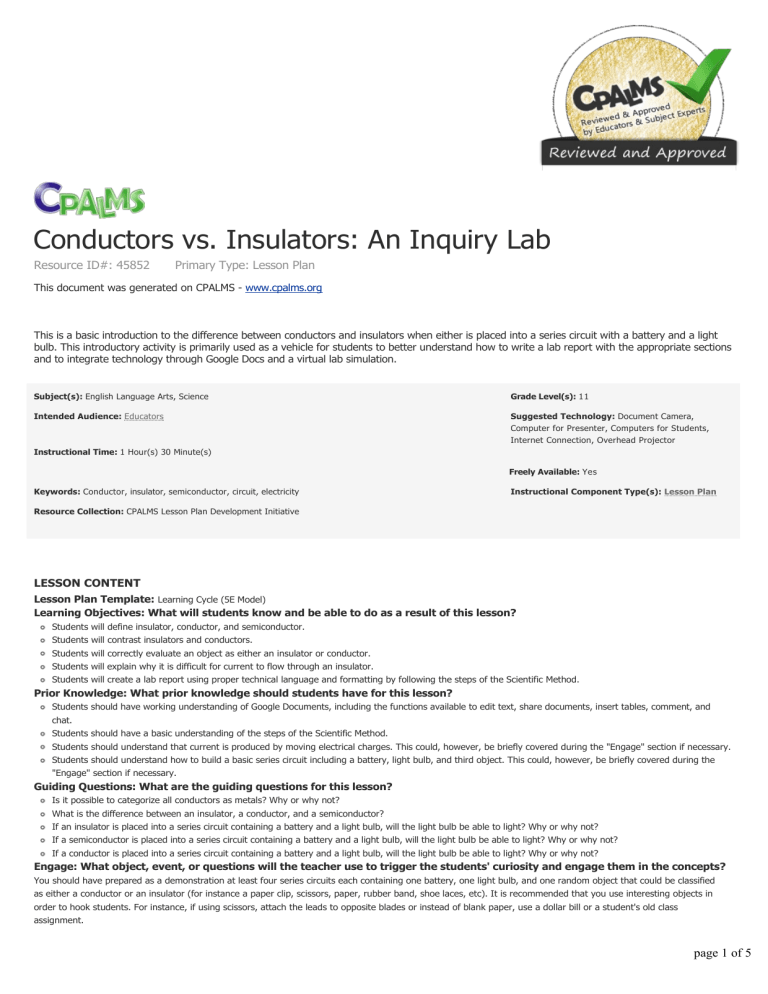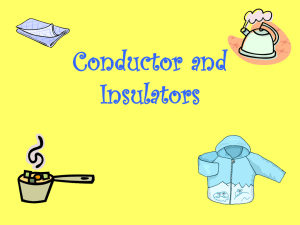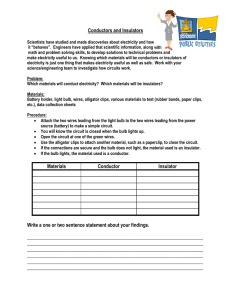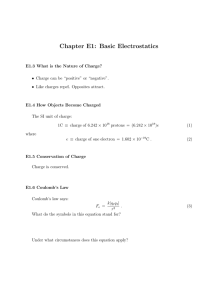Conductors vs. Insulators: An Inquiry Lab

Conductors vs. Insulators: An Inquiry Lab
Resource ID#: 45852 Primary Type: Lesson Plan
This document was generated on CPALMS - www.cpalms.org
This is a basic introduction to the difference between conductors and insulators when either is placed into a series circuit with a battery and a light bulb. This introductory activity is primarily used as a vehicle for students to better understand how to write a lab report with the appropriate sections and to integrate technology through Google Docs and a virtual lab simulation.
Subject(s): English Language Arts, Science
Intended Audience: Educators
Instructional Time: 1 Hour(s) 30 Minute(s)
Keywords: Conductor, insulator, semiconductor, circuit, electricity
Resource Collection: CPALMS Lesson Plan Development Initiative
Grade Level(s): 11
Suggested Technology: Document Camera,
Computer for Presenter, Computers for Students,
Internet Connection, Overhead Projector
Freely Available: Yes
Instructional Component Type(s): Lesson Plan
LESSON CONTENT
Lesson Plan Template: Learning Cycle (5E Model)
Learning Objectives: What will students know and be able to do as a result of this lesson?
Students will define insulator, conductor, and semiconductor.
Students will contrast insulators and conductors.
Students will correctly evaluate an object as either an insulator or conductor.
Students will explain why it is difficult for current to flow through an insulator.
Students will create a lab report using proper technical language and formatting by following the steps of the Scientific Method.
Prior Knowledge: What prior knowledge should students have for this lesson?
Students should have working understanding of Google Documents, including the functions available to edit text, share documents, insert tables, comment, and chat.
Students should have a basic understanding of the steps of the Scientific Method.
Students should understand that current is produced by moving electrical charges. This could, however, be briefly covered during the "Engage" section if necessary.
Students should understand how to build a basic series circuit including a battery, light bulb, and third object. This could, however, be briefly covered during the
"Engage" section if necessary.
Guiding Questions: What are the guiding questions for this lesson?
Is it possible to categorize all conductors as metals? Why or why not?
What is the difference between an insulator, a conductor, and a semiconductor?
If an insulator is placed into a series circuit containing a battery and a light bulb, will the light bulb be able to light? Why or why not?
If a semiconductor is placed into a series circuit containing a battery and a light bulb, will the light bulb be able to light? Why or why not?
If a conductor is placed into a series circuit containing a battery and a light bulb, will the light bulb be able to light? Why or why not?
Engage: What object, event, or questions will the teacher use to trigger the students' curiosity and engage them in the concepts?
You should have prepared as a demonstration at least four series circuits each containing one battery, one light bulb, and one random object that could be classified as either a conductor or an insulator (for instance a paper clip, scissors, paper, rubber band, shoe laces, etc). It is recommended that you use interesting objects in order to hook students. For instance, if using scissors, attach the leads to opposite blades or instead of blank paper, use a dollar bill or a student's old class assignment.
page 1 of 5
Either use an overhead projector or have students file by and observe the circuits and observe the differences. Before showing the circuits to the students (or before hooking them up), you should indicate to the students that some circuits have insulators and some have conductors, but do not tell students which are which.
After students have observed the demonstration, allow a minute or two for student-led discussion. Have students discuss in pairs which objects they believe are insulators and which are conductors and how they arrived at that conclusion. Then have a few students share their ideas with the class before moving on to the lab activity.
Explore: What will the students do to explore the concepts and skills being developed through the lesson?
Conductivity Inquiry Lab Write-up
Conductivity Inquiry Lab - Student Lab Report Sample
Conductivity Inquiry Lab - Lab Report Rubric
Conductivity Inquiry Lab - Simulation Link
Students will write a full lab report with seven sections: Identify, Hypothesis, Materials, Procedure, Data, Analysis, Conclusion. The attached document will guide students through this process. This lab will be conducted through inquiry - the attached document gives instructions and guidance, but not a procedure.
The intent of the lab is to allow students to understand which materials are conductors and which are insulators and why while also leading students through creating a properly formatted lab report. It is recommended that students complete this lab report in pairs using Google Docs. Students begin by creating a Document and sharing it with both their partner and their teacher. If there are enough computers for each student, then each partner may edit the document simultaneously and can each be held accountable for their contributions.
During this portion of the activity, it would be ideal if the teacher were also logged onto Google Docs and virtually monitored students for progress and understanding.
Teachers can watch as students edit their documents and give immediate feedback through either the "comment" or the "chat" feature of Google Docs.
Because the lab report itself is typed on a computer, it is also recommended that the lab activity (attached) is posted for the students to read digitally such as on your class's website. The lab itself is a virtual lab as written up. The lab could also be completed in the classroom if the materials are available.
Explain: What will the students and teacher do so students have opportunities to clarify their ideas, reach a conclusion or generalization, and communicate what they know to others?
The "Explain" section is covered in the "Analysis" portion of the inquiry lab. This section of the lab guides students to understand the difference in properties between insulators and conductors.
As groups reach this portion of the lab activity, the teacher should meet with groups one-on-one to discuss findings and conduct formative assessment. The teacher guide students through creating their own definitions for conductor and insulator (or reviews definitions that students may have already created).
During this section, the teacher should also discuss student misconceptions one-on-one, as evidenced by discrepancies between hypotheses and results. For instance, most students will not hypothesize that distilled water is an insulator or graphite is a conductor. Through this discussion, teachers can lead students to understand the underlying property of conductors (the ability of electrons to flow, either through valence electrons or ions).
Elaborate: What will the students do to apply their conceptual understanding and skills to solve a problem, make a decision, perform a task, or make sense of new knowledge?
The Elaborate section is covered in the "Conclusion" portion of the inquiry lab, in which students write a three to five paragraph conclusion discussing the principles discovered through the lab.
After reviewing the Analysis portion one-on-one (the Explain section above), teachers should have students independently write a conclusion according to the instructions in the lab write-up.
Once the class has completed the lab report, the teacher should show the following video to reinforce understanding of semiconductors: Semiconductors and Modern
Technology - YouTube Video . Teachers need only show from time 2:15- 3:45, as this is the portion of the video relevant to the lesson. However, if students have access to YouTube and each student has a laptop with headphones, the teacher could also have each student watch the entire video after finishing writing their lab report or after they have finished the Analysis section (and before writing the conclusion).
Summative Assessment
Drawing project: connects concepts learned to visual understanding
Students draw three pictures of three different objects placed into series circuits like those they built in the lab activity. One object should be an insulator, one a conductor, and one a semiconductor. Instruct students to include electrons in their drawings in order to show the difference between an insulator, a conductor, and a semiconductor. The drawings should also show whether the light bulb lights in each of the cases. Below the drawing, the student should include a caption indicating whether the object is a conductor, insulator, or semiconductor and how that is shown by the drawing.
Students are graded on their visual representation of the difference between insulators and conductors, their captions, and the correctness and neatness of their drawings:
Summative Assessment - Drawing Project Rubric
Students are assessed for the Florida Standards portion of this lesson through their lab report. A rubric to grade this lab report is attached in the "Explain" section.
Formative Assessment
Diagnostic assessment will occur during the student-led discussion of the Engage section, which will reveal prior student knowledge on the topic.
Formative assessment will occur throughout the Explore and Explain sections. During the explore session, the teacher will monitor as students complete the lab activity and lab report through Google Docs.
During the Explain section, the teacher will have one-on-one conversation with students concerning ideas gained through the lab activity. Specifically, teachers should ask the following questions:
1. What happens when an insulator is placed in a circuit? What happens when a conductor is placed in a circuit?
2. What is the difference between conductors and insulators?
3. How could a semiconductor be defined based upon this knowledge?
page 2 of 5
4. What property do you think allows current to flow through conductors but not insulators?
5. Are conductors always metals? Why or why not?
Answers to formative assessment questions:
1. When an insulator is placed in a circuit, electricity is unable to flow and the light bulb does not light. When a conductor is placed in a circuit, electricity flows and the light bulb lights.
2. A conductor is a material that allows electrons to easily flow, while an insulator is a material that does not allow electrons to easily flow.
3. By breaking down the word, a semiconductor is a material that falls halfway between an insulator and a conductor. It is neither a good insulator nor a good conductor.
4. Conductors have electrons that can easily be moved, either because they have easily removed valence electrons or free moving ions.
5. Conductors are not always metals; for instance, graphite and saltwater are both good conductors that are present in the experiment. Conductors are simply materials through which electrons may easily flow.
Feedback to Students
Students will receive immediate feedback as the instructor monitors during the lab activity. Teachers should give feedback through "comments" and "chat" on Google
Docs as students write their reports. Alternatively, teachers may circulate during this time and give verbal feedback on student progress.
Students will receive direct feedback during one-on-one instruction/discussion during the Explain portion of the lab.
After the lab report is completed, the teacher will give students feedback on their lab reports using the attached rubric.
ACCOMMODATIONS & RECOMMENDATIONS
Accommodations:
In order to accommodate students with special needs, it would be ideal to group these students together, either in pairs or in small groups. In this small group setting, the students can receive additional support and guidance, particularly with writing the procedure.
It may also be helpful to provide these students with a partially filled in lab report, such as the attached below.
Lab Report Outline for Differentiation
Extensions:
Extension for Advanced Students:
After establishing the difference between insulators and conductors, students choose five objects from around the classroom and predict whether they are insulators or conductors. Students then build a series circuit using each object, one battery, and one light bulb to verify their predictions.
Students then write a paragraph to explain their findings. Alternatively, time permitting, students could present their findings to the class and explain to the class the difference between insulators and conductors.
Suggested Technology: Document Camera, Computer for Presenter, Computers for Students, Internet Connection, Overhead Projector
Special Materials Needed:
For demo: at least four series circuits, each containing:
Battery (in battery holder, if available)
Light bulb (in holder, if available)
Object that can be classified as conductor or insulator, such as rubber band, paper clip, scissors, paper, etc
Three insulated wires with alligator clips to connect circuit
For virtual lab: one computer for each student, with Google Docs available
For hands-on lab (optional): one circuit set up for each pair/group, including
Battery (in holder, if available)
Light bulb (in holder, if available)
Various insulator/conductor objects from materials list in lab (glass, graphite, metal, rubber, plastic)
Three insulated wires to complete circuit with alligator clips
One computer per student (ideal) or per group
This hands-on set-up is also required if the extension for advanced students is employed.
For summative assessment, each students will need: drawing paper (such as computer paper) drawing utensils (crayons, colored pencils, markers, etc)
Further Recommendations:
The lab activity for this lesson is quite straightforward. The focus is on integrating technology through Google Docs and writing a properly formatted lab report.
Most students will have the misconception that all conductors are metal and thus will be surprised when objects such as graphite and saltwater prove to be conductors.
page 3 of 5
Because this lab is technology based, instead of a traditional hands-on lab, it is most helpful for the lab to be completed in pairs instead of in small groups. Students should be paired with another student of similar ability. If students of extreme abilities are paired, then it is likely that they will not get as much out of the activity.
SOURCE AND ACCESS INFORMATION
Contributed by: Eliza Gonsalves
Name of Author/Source: Eliza Gonsalves
District/Organization of Contributor(s): Brevard
Is this Resource freely Available? Yes
Access Privileges: Public
License: CPALMS License - no distribution - non commercial
Related Standards
Name
LAFS.1112.WHST.1.2:
SC.912.N.1.1:
Description
Write informative/explanatory texts, including the narration of historical events, scientific procedures/ experiments, or technical processes.
a. Introduce a topic and organize complex ideas, concepts, and information so that each new element builds on that which precedes it to create a unified whole; include formatting (e.g., headings), graphics (e.g., figures, tables), and multimedia when useful to aiding comprehension.
b. Develop the topic thoroughly by selecting the most significant and relevant facts, extended definitions, concrete details, quotations, or other information and examples appropriate to the audience’s knowledge of the topic.
c. Use varied transitions and sentence structures to link the major sections of the text, create cohesion, and clarify the relationships among complex ideas and concepts.
d. Use precise language, domain-specific vocabulary and techniques such as metaphor, simile, and analogy to manage the complexity of the topic; convey a knowledgeable stance in a style that responds to the discipline and context as well as to the expertise of likely readers.
e. Provide a concluding statement or section that follows from and supports the information or explanation provided
(e.g., articulating implications or the significance of the topic).
Define a problem based on a specific body of knowledge, for example: biology, chemistry, physics, and earth/space science, and do the following:
1. Pose questions about the natural world, (A rticulate the purpose of the investigation and identify the relevant scientific concepts).
2. Conduct systematic observations, ( Write procedures that are clear and replicable. Identify observables and examine relationships between test (independent) variable and outcome (dependent) variable. Employ appropriate methods for accurate and consistent observations; conduct and record measurements at appropriate levels of precision. Follow safety guidelines).
3. Examine books and other sources of information to see what is already known,
4. Review what is known in light of empirical evidence, ( Examine whether available empirical evidence can be interpreted in terms of existing knowledge and models, and if not, modify or develop new models).
5. Plan investigations, ( Design and evaluate a scientific investigation).
6. Use tools to gather, analyze, and interpret data (this includes the use of measurement in metric and other systems, and also the generation and interpretation of graphical representations of data, including data tables and graphs), (Collect data or evidence in an organized way. Properly use instruments, equipment, and materials (e.g., scales, probeware, meter sticks, microscopes, computers) including set-up, calibration, technique, maintenance, and storage).
7. Pose answers, explanations, or descriptions of events,
8. Generate explanations that explicate or describe natural phenomena (inferences),
9. Use appropriate evidence and reasoning to justify these explanations to others,
10. Communicate results of scientific investigations, and
11. Evaluate the merits of the explanations produced by others.
Remarks/Examples:
Florida Standards Connections for 6-12 Literacy in Science
For Students in Grades 9-10
LAFS.910.RST.1.1 Cite specific textual evidence to support analysis of science and technical texts, attending to the precise details of explanations or descriptions.
LAFS.910.RST.1.3 Follow precisely a complex multistep procedure when carrying out experiments , taking measurements, or performing technical tasks attending to special cases or exceptions defined in the text.
LAFS.910.RST.3.7 Translate quantitative or technical information expressed in words in a text into visual form
(e.g., a table or chart) and translate information expressed visually or mathematically (e.g., in an equation) into words.
LAFS.910.WHST.1.2 Write informative/explanatory texts, including the narration of historical events, scientific procedures/ experiments , or technical processes.
LAFS.910.WHST.3.9 Draw evidence from informational texts to support analysis, reflection, and research.
For Students in Grades 11-12
page 4 of 5
SC.912.P.10.14:
LAFS.1112.RST.1.1 Cite specific textual evidence to support analysis of science and technical texts, attending to important distinctions the author makes and to any gaps or inconsistencies in the account.
LAFS.1112.RST.1.3 Follow precisely a complex multistep procedure when carrying out experiments , taking measurements, or performing technical tasks analyze the specific results based on explanations in the text.
LAFS.1112.RST.3.7 Integrate and evaluate multiple sources of information presented in diverse formats and media (e.g., quantitative data, video, multimedia) in order to address a question or solve a problem.
LAFS.1112.WHST.1.2 Write informative/explanatory texts, including the narration of historical events, scientific procedures/ experiments , or technical processes.
LAFS.1112.WHST.3.9 Draw evidence from informational texts to support analysis, reflection, and research.
Florida Standards Connections for Mathematical Practices
MAFS.K12.MP.1: Make sense of problems and persevere in solving them.
MAFS.K12.MP.2: Reason abstractly and quantitatively.
MAFS.K12.MP.3: Construct viable arguments and critique the reasoning of others. [Viable arguments include evidence.]
MAFS.K12.MP.4: Model with mathematics.
MAFS.K12.MP.5: Use appropriate tools strategically.
MAFS.K12.MP.6: Attend to precision.
MAFS.K12.MP.7: Look for and make use of structure.
MAFS.K12.MP.8: Look for and express regularity in repeated reasoning.
Differentiate among conductors, semiconductors, and insulators.
Remarks/Examples:
Describe band structure, valence electrons , and how the charges flow or rearrange themselves between conductors and insulators .






